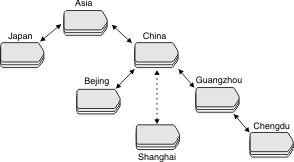Hierarchical Tree Topology
A hierarchical tree consists of a root database server and one or more database servers organized into a tree topology.

- Asia is the parent of China and Japan.
- China is the child of Asia and the parent of Beijing, Shanghai, and Guangzhou.
- Guangzhou is the child of China and the parent of Chengdu.
Asia is the root database server. Japan, China, and Guangzhou are nonroot database servers. You can define Beijing, Shanghai, and Chengdu as either nonroot database servers or leaf database servers, depending on how you plan to use them. The dashed connection from China to Shanghai indicates that Shanghai is a leaf server.
You can define a replicate that replicates data exclusively between Shanghai and Japan. However, the transaction data would must go through China and Asia. If either China or Asia is offline replication is suspended. Similarly, a replicate defined between Japan and China would require Asia to be functioning, even though both Japan and China, as nonroot servers, have entries in their sqlhosts files for each other.
Parent servers are good candidates for using high-availability clusters to provide backup servers.